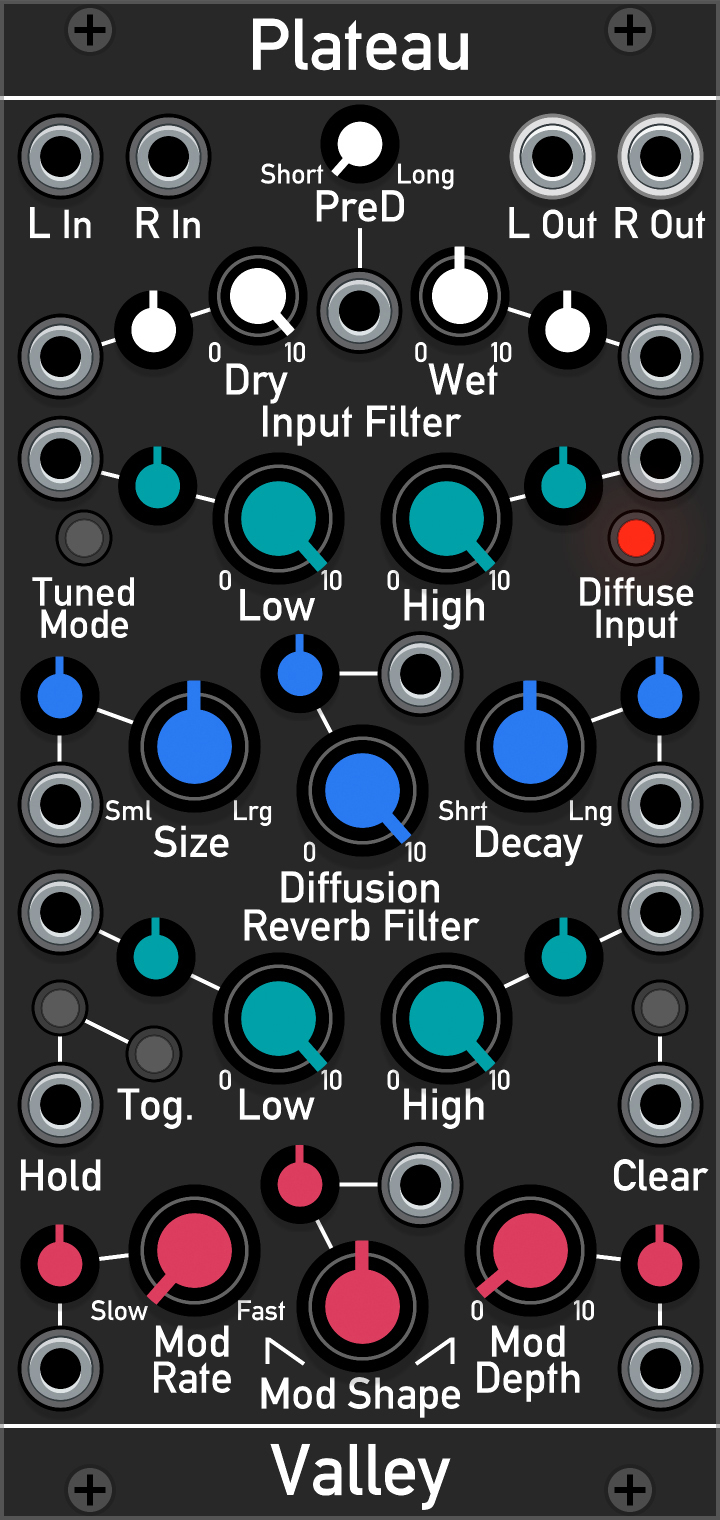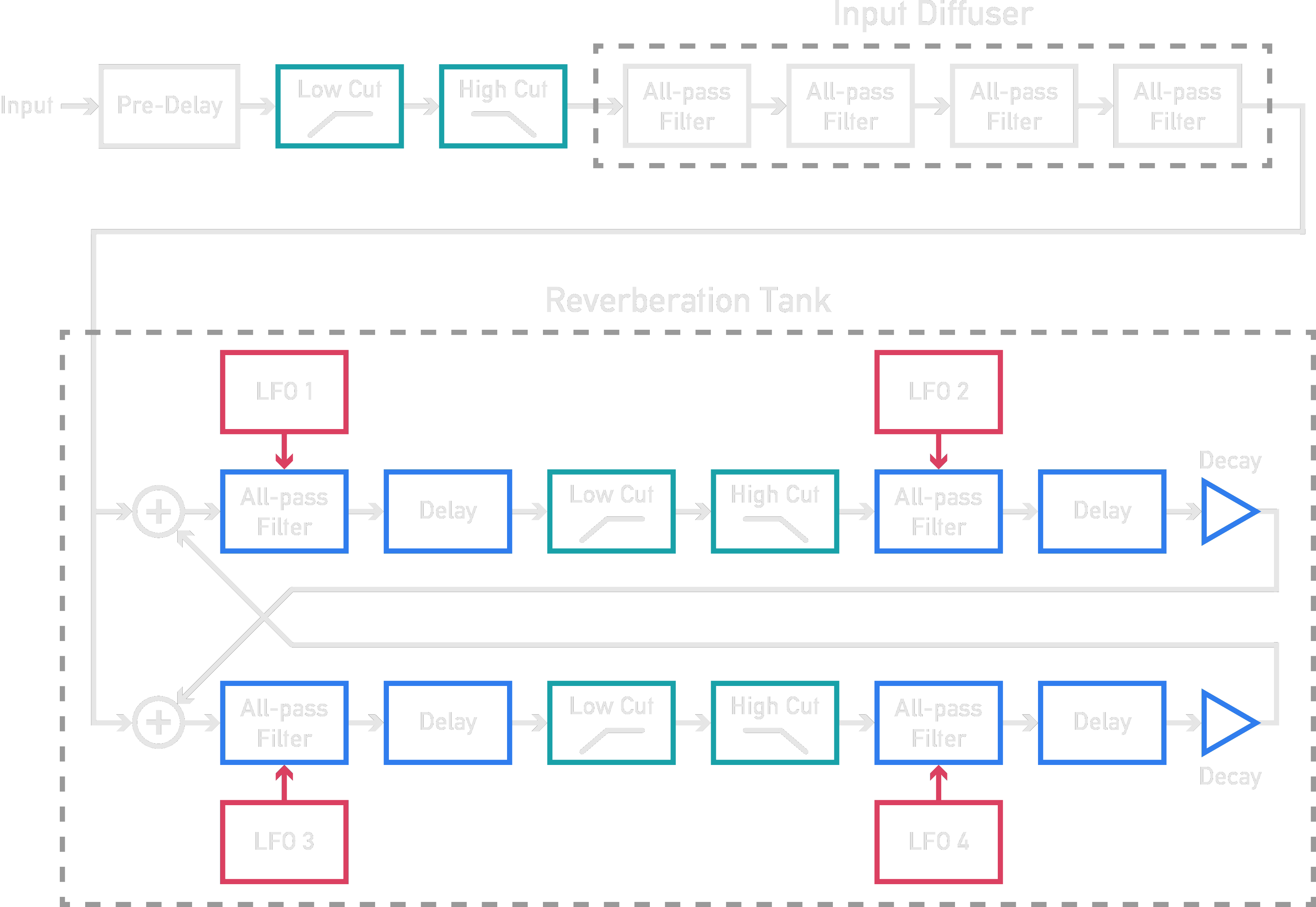Plateau
Lush plate reverb

Plateau is a plate reverb module based on the famous, Dattorro (1997) design, and is designed to make a dry, lifeless patch sound lush, deep and spacious. However, unlike other reverberators, Plateau attempts to go beyond, providing a wide variety of control combinations and options.
Contents
User Guide
All of the controls on Plateau have CV inputs available allowing for full automation of all parameters.
Knobs
- Dry & Wet: Control the levels of the original and reverberant signals.
- PreD: Pre-delay. Determines the delay for when the original signal is fed into the reveberator. Ranges from 0 to 500ms.
- Low and High: Input and reverberator filters.
- Size: Sets the overall delay time and apparent 'size' of the reverb. Ranges from very short to extremely long.
- Diffusion: Controls how diffused and smeared the reverb is. No diffusion results in audible echoes.
- Decay: Sets the speed at which the signal decays over time. The maximum setting results in a long reverb that evolves over time into a very slowly dying cloud of sound.
- Diffuse Input: Enages the input diffusion stage that pre-diffuses and smears the signal before reverberation. Bypassing the stage sharpens the input signal.
- Tuned Mode: Shortens the delay times and tunes the all-pass filters to 1V/Oct so that the reverb can be 'played'.
Buttons
- Hold: Sets the decay of the reverb to infinite so that it will continuously reverberate.
- Tog: Sets the 'Hold' switch to be either toggled or momentary
- Clear: Purges the reverberator. Useful for creating gated reverb effects, or diminshing complete chaos.
How it works
Plateau is based upon the popular Dattorro (1997) digital plate reverb design. The flow diagram below shows a simplified version of the algorithm.

The audio is initially pre-delayed and equalised before passing through the 'Input Diffuser' which smears and diffuses the signal. In Plateau, there is the option to bypass this stage.
Next, the diffused signal is passed into the 'Reverberation Tank' which is two chains of filters arranged in parallel. The chains are fed into each other to continuously diffuse the signal and build up a dense reverberation. The reverb decays over time thanks to the equalisation and decay stages after each chain. The left and right output signals are extracted from this tank at several tap points (not shown).
Dattorro (1997) found that unpleasant ringing can build up over time. To combat this, the delay times of the all-pass filters in the tank are subtly modulated by low frequency oscillators (LFOs). This modulation changes the resonant frequency of the reverberator over-time to supress the ringing. This also slowly changes the reflection pattern so that it appears to continuously vary. With moderate modulation, this results in an audible pitch shifting.
Video Demos
Omri Cohen gives a nice introductory tutorial for Plateau.
Martin of ML_Modules composed this beautiful, ambient patch that presents the lush reverb that can be easily achieved.
Finetales demos the dreaminess that Plateau can add to a simple synth patch.
Artem from VCV Rack Ideas showcases some unusual and alternative uses of Plateau, demonstrating that it is not just another reverb.
Bibliography
Dattorro, J. (1997). Effect design part 1: Reverberator and other filters, J. Audio Eng. Soc, 45(9), 660-684.